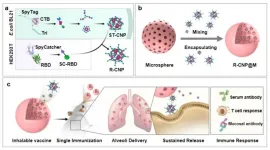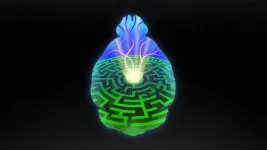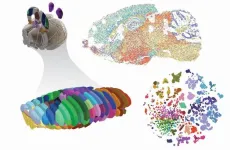(Press-News.org) Infusions of potentially therapeutic cells derived from the heart are safe for people with pulmonary arterial hypertension, a form of high blood pressure that occurs in the blood vessels of the lungs and typically affects middle-aged women, according to a study led by Cedars-Sinai investigators.
The Phase I clinical trial results are published in the peer-reviewed journal eBioMedicine, a Lancet journal.
“Although several drugs are approved for pulmonary arterial hypertension, mortality remains high,” said Eduardo Marbán, MD, PhD, executive director of the Smidt Heart Institute at Cedars-Sinai, the Mark S. Siegel Family Foundation Distinguished Professor and senior author of the study. “We tried a fundamentally different approach—cell therapy delivered into the pulmonary artery—and found encouraging results, in patients already on combination conventional therapy."
Pulmonary arterial hypertension is a rare disease, affecting fewer than 100 people per million. There currently is no cure and the average median life expectancy on treatment for most patients is roughly 6.2 years after diagnosis.
Currently approved medications for the condition aim to open up blood vessels in the lungs, allowing for better blood flow; however, studies on lungs in patients on treatment still show severe occlusive vessel changes. Further, these medications don’t address many of the complex underlying mechanisms that cause the high pulmonary pressures. Even on medication, people with pulmonary arterial hypertension can develop severe dysfunction in the right ventricle of the heart, the part that pumps blood to the lungs and whose function correlates best with survival.
Cedars-Sinai investigators are experimenting with using cardiosphere-derived cells (CDCs) to address some of the biological processes involved in pulmonary arterial hypertension. CDCs were first developed and characterized by Marbán. They have been used in multiple clinical trials for a variety of diseases, most recently, Duchenne muscular dystrophy. These are cells derived from human heart tissue that Marbán and colleagues have discovered reduce inflammation in the body and exert beneficial effects on the immune system.
Called the ALPHA study, this clinical trial was conducted in two phases. In the first, six people with pulmonary arterial hypertension received an infusion of CDCs into their lungs. Three patients received an infusion of 50 million CDCs and the other three received an infusion of 100 million CDCs.
In the second phase, 10 people with pulmonary arterial hypertension were randomized to receive an infusion of 100 million CDCs and 10 people were randomized to receive infusions containing a placebo. Investigators performed right heart catheterization and cardiac MR imaging on each study participant before the infusions and four months after the infusions.
All the participants were on combination pulmonary arterial hypertension-specific medications throughout the course of the study.
The investigators tracked the health of participants for 12 months after the infusions. No adverse effects related to the infusions occurred during this time. Although this study was only designed to assess the safety of the CDC infusions, the investigators observed encouraging changes that might indicate the 16 people who had received the CDC infusions had improved cardiopulmonary health. People who received the infusions, for example, showed improved functioning in the heart’s right ventricle and, at two months post-infusion, were able to walk a greater distance during a six-minute test than people who received placebo.
“The most important takeaway is that this approach is safe and feasible to do in people with pulmonary arterial hypertension,” said Michael I. Lewis, MD, director of Respiratory Care Services at Cedars-Sinai, and first and corresponding author of the study. “These are encouraging exploratory findings that motivate moving on to more advanced studies.”
The investigators plan additional trials to study the effects of repeated infusions of CDCs given to people with pulmonary arterial hypertension.
Cedars-Sinai investigators Mamoo Nakamura, MD; Dael Geft, MD; Yuri Matusov, MD; James Mirocha; Antoine Hage, MD; Victor Tapson, MD; Oleg A. Karpov, PhD; and Jennifer Van Eyk, PhD, also worked on the study.
Funding: The study was funded by the California Institute for Regenerative Medicine (CIRM), one of the world’s largest institutions dedicated to three key areas of regenerative medicine—research, education and patient access.
END
Unique cell-based approach for pulmonary arterial hypertension shown to be safe
Phase I trial results also hint at improved cardiopulmonary function in people with this life-threatening condition
2023-12-13
ELSE PRESS RELEASES FROM THIS DATE:
Study analyzes what babies hear, say on six continents
2023-12-13
Elika Bergelson, associate professor of psychology at Harvard University, studies how infants and toddlers learn language from the world around them. The developmental psychologist specifically strives to parse the various theories that account for the onset and eventual mastery of language comprehension and production. Bergelson’s latest paper, published this month in the Proceedings of the National Academy of Sciences, represents a more global approach to developing and testing such theories.
Written ...
Heart attack deaths spike during the winter holidays
2023-12-13
DALLAS, Dec. 13, 2023 — The winter holidays can turn deadly as research shows that more people die from heart attacks during the last week of December than at any other time of the year. While being aware of the signs of a heart attack and taking steps to reduce your risk are important all year long, the American Heart Association, the world’s leading voluntary organization focused on heart and brain health for all, says that’s especially critical during the next few weeks.
A number of scientific studies confirm ...
MD Anderson Research Highlights for December 13, 2023
2023-12-13
HOUSTON ― The University of Texas MD Anderson Cancer Center’s Research Highlights showcases the latest breakthroughs in cancer care, research and prevention. These advances are made possible through seamless collaboration between MD Anderson’s world-leading clinicians and scientists, bringing discoveries from the lab to the clinic and back.
Recent developments at MD Anderson include a novel blood-based test to predict lung cancer relapses, improved detection of genes associated with complex traits, insights into how B cell activity influences immunodeficiency, novel targets that drive treatment ...
DNA discovery opens door to personalised medicine for Indigenous Australians
2023-12-13
The most comprehensive analysis of Indigenous Australians’ genomes collected to date has revealed an “abundance” of DNA variations – some of which have never been reported anywhere else in the world – paving the way for new, personalised treatments that address health inequities for Aboriginal and Torres Strait Islander peoples.
A team of Australian researchers, led by scientists from The Australian National University (ANU), found DNA differences between Indigenous Australians living in the Tiwi Islands and Indigenous peoples living in the Australian ...
Researchers develop a novel dry-powder inhaled vaccine platform
2023-12-13
Researchers from the Institute of Process Engineering (IPE) of the Chinese Academy of Sciences have proposed a new “nano-micro composite” delivery concept for vaccines. Based on this idea, they have developed a single-dose, dry-powder, inhalable vaccine platform using nano-micro composite multilevel structures, which has been successfully prepared in the laboratory, and the vaccine has been shown to be effective in blocking respiratory viral infection and transmission in animal models. This platform holds great promise for combating future emerging and epidemic infectious diseases.
This ...
Growing use of hemp-derived alternative cannabis products containing CBD, Delta-8-THC, CBG, CBN
2023-12-13
Cannabis use for medicinal or recreational purposes is now permitted is most states in the U.S. Many of the products sold in dispensaries contain delta-9-tetrahydrocannabinol (better known as “THC”), and are thus classified as Schedule I drugs, making them illegal under federal law.
However, there is a parallel market for products derived from hemp—defined as cannabis containing less that 0.3 percent THC—spurred in part by the passage of the 2018 Farm Bill, which removed hemp-derived cannabinoids from the federal Controlled Substances Act.
A new U-M study published in JAMA Network Open examines past-year use of some of these hemp-derived ...
Penn Medicine research shows how stress activates neurons that disrupt sleep
2023-12-13
PHILADELPHIA— New research reveals that neurons in the preoptic hypothalamus—the region of the brain that regulates sleep and body temperature—are rhythmically activated during non-rapid eye movement sleep (NREM). Stress activates these brain cells out of turn, causing “microarousals,” that interrupt sleep cycles and decrease the duration of sleep episodes, according to research from Perelman School of Medicine at the University of Pennsylvania, published today in Current Biology.
While our bodies are at rest when we are asleep, ...
New study sheds light on how the brain learns to seek reward
2023-12-13
By Jake Siegel
Imagine you’re teaching a dog to play fetch. You throw a ball, and your dog sprints after it, picks it up, and runs back. You then reward your panting pup with a treat. But now comes the real trick for your dog: figuring out which part of that sequence earned the treat. Scientists call this the 'credit assignment problem' in the brain. It's a fundamental question about understanding which actions are responsible for the positive outcomes we experience.
Dopamine, a key chemical ...
Salk teams assemble first full epigenomic cell atlas of the mouse brain
2023-12-13
LA JOLLA (December 14, 2023)—Salk Institute researchers, as part of a worldwide initiative to revolutionize scientists’ understanding of the brain, analyzed more than 2 million brain cells from mice to assemble the most complete atlas ever of the mouse brain. Their work, published December 14, 2023 in a special issue of Nature, not only details the thousands of cell types present in the brain but also how those cells connect and the genes and regulatory programs that are active in each cell.
The efforts were coordinated by the National Institutes of Health’s Brain Research Through Advancing Innovative Neurotechnologies® Initiative, or the BRAIN Initiative®, ...
Scientists unveil first complete cellular map of adult mouse brain
2023-12-13
By Jake Siegel
Six years and 32 million cells later, scientists have created the first full cellular map of a mammalian brain. In a set of 10 papers in Nature today, a network of researchers unveiled an atlas cataloging the location and type of every cell in the adult mouse brain. Using advanced technologies that profile individual cells, the teams identified over 5,300 cell types – far more than known before – and pinpointed their locations within the brain’s intricate geography. ...
LAST 30 PRESS RELEASES:
Rare image of Tatooine-like planet is closest to its twin stars yet
Music: Popular song lyrics have become more negative since 1973
Marine ecology: Killer whales tail dolphins to hunt salmon
ADHD prescriptions on the rise, study finds
How to build a genome
Sharp rise in ADHD stimulant prescriptions in Ontario, research finds
Trends and prevalence of the metabolic syndrome among US adults
Population-level trends in ADHD medication prescribing
Missing piece of myelin disturbs the brain’s rhythm
Insilico Medicine and Taigen achieves license agreement to develop and commercialize AI-driven PHD inhibitor for anemia of Chronic Kidney Disease (CKD)
Exploring dominant endophytic Pleosporales in grasses: New taxonomic insights in the suborder Massarineae
Comparative transcriptomic analysis of human maxillary and mandibular tooth germs reveals discrepancies in gene expression patterns
Scientists detect atmosphere on molten rocky exoplanet - study
Chip-scale magnetometer uses light for high-precision magnetic sensing
Illinois Tech biomedical engineering professor Philip R. Troyk elected as Fellow of the National Academy of Inventors
The National Academy of Inventors welcomes 2025 Class of Fellows
Multi-scale modelling framework predicts mechanical responses of Fe–Cr–Al alloys across composition and processing conditions
Preoperative radiation may improve antitumor immune response in most common form of breast cancer
Breast MRI may be safely omitted from diagnostic workup in certain patients with early-stage, HR-negative breast cancer
Sentinel lymph node biopsy may be safely omitted in some patients with early-stage breast cancer
Rats may seek cannabis to cope with stress
New FAU research strengthens evidence linking alcohol use to cancer
Gut health à la CAR T
Dr. Pengfei Liu receives 2026 O'Donnell Award in Medicine for pioneering advances in genetic diagnostics and rare disease treatment
Dr. Yunsun Nam receives 2026 O'Donnell Award in Biological Sciences for pioneering RNA research transforming gene regulation and cancer therapy
Dr. Bilal Akin wins 2026 O'Donnell Award in Engineering for transformative work in EV energy systems and industrial automation
Dr. Fan Zhang receives 2026 O'Donnell Award in Physical Sciences for groundbreaking discoveries in quantum matter and topological physics
Dr. Yue Hu receives 2026 O'Donnell Award for revolutionizing energy operations with real-time AI and reinforcement learning
Greater risk that the political right falls for conspiracy theories
JMC Publication: Insilico’s AI platforms enable discovery of potent, selective, oral DGKα inhibitor to overcome checkpoint resistance
[Press-News.org] Unique cell-based approach for pulmonary arterial hypertension shown to be safePhase I trial results also hint at improved cardiopulmonary function in people with this life-threatening condition




